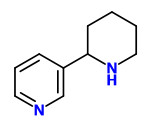Nicotiana glauca Graham - Solanaceae - tree tobacco, mustard tree, glaucous-leaf tobacco, wild tobacco, Blaugrüner Tabak, Baumtabak, Strauchtabak
Shrub or small tree, native to South America (Bolivia, Argentina), naturalized elsewhere; leaves long-petioled, ovate, leathery, entire; inflorescences many-flowered lax panicles; flowers tubular, corolla yellow, 2.5-4.5 cm.
http://www.efloras.org/florataxon.aspx?flora_id=2&taxon_id=200020548
Infusions of the leaves were used by by Native Americans as an emetic. A poultice of them was applied to inflamed throat glands, cuts, bruises, swellings and other wounds, and for removing the pus from scrofulous sores or boils. http://herb.umd.umich.edu/herb/search.pl?searchstring=Nicotiana+glauca
β-pyridyl-α'-piperidine, called anabasine, isomeric with nicotine, was shown to be the main alkaloid in N.glauca (and a minor alkaloid in N.tabacum).
[Occurrence of anabasine in Nicotiana glauca R. Grah.(Solanaceae)., Smith, C.R., Journal of the American Chemical Society, 57(5), 1935, 959-960]
The leaves are poisonous by ingesetion. Patients are confronted with life-threatening motor paresis. In addition to severe muscle weakness, bulbar palsies, flexor muscle spasm, hypertension, nausea, vomiting, and respiratory compromise were reported.
[Neuromuscular blockade after ingestion of tree tobacco (Nicotiana glauca)., Mellick, L.B., Makowski, T., Mellick, G.A., Borger, R., Annals of emergency medicine, 34(1), 1999, 101-104]

Curtis’s Botanical Magazine, vol.55 [ser.2, vol.2] t.2837 (1828) [W.J.Hooker]
http://plantgenera.org/species.php?id_species=700780
